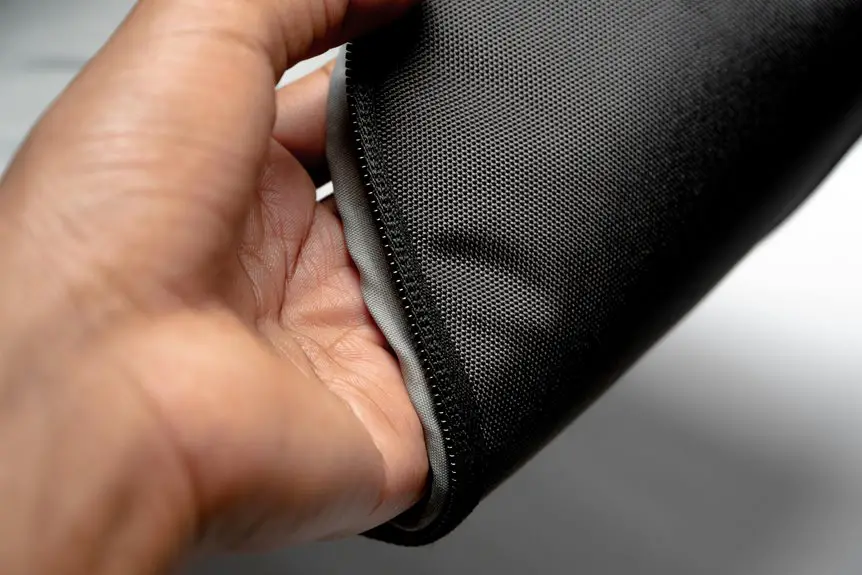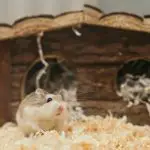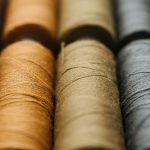When you have pets, selecting the right fabrics for your home isn’t just about style—it’s about practicality. You need materials that can withstand scratches, spills, and the occasional accident. It’s essential to find options that resist stains and control odors. But how do you balance durability with aesthetics? Let’s explore some key factors that will help you make informed choices for a pet-friendly environment.
Table of Contents
Key Takeaways
- Opt for tightly woven fabrics like canvas and denim for superior durability against pet wear and tear.
- Choose stain-resistant materials with advanced treatments for easier clean-ups and to protect against spills.
- Synthetic fibers such as polyester and nylon are tougher, easier to clean, and repel odors better than natural fabrics.
- Consider fabrics with antimicrobial treatments to control odors and maintain freshness in pet-friendly homes.
- Evaluate your pet’s habits to select the most suitable fabric type, balancing durability, comfort, and ease of maintenance.
Understanding Fabric Durability for Pet Owners
When you’re a pet owner, choosing the right fabric is essential for maintaining both your home’s style and your sanity. You need durable materials that can withstand the wear and tear your furry friends bring.
Look for tightly woven fabrics like canvas or denim; they resist snagging and tearing better than softer textiles. Synthetic fibers such as polyester and nylon are also great choices, as they’re tough and easy to clean.
Avoid delicate fabrics like silk or lightweight cotton, which mightn’t hold up to claws and paws.
The Importance of Stain Resistance in Pet-Friendly Fabrics
When you’re choosing fabrics for your home, stain resistance is a must-have, especially with pets around.
Liquid resistance can save you time and stress by making clean-ups easier.
Plus, advancements in treatment technologies mean you can enjoy stylish fabrics without worrying about everyday messes.
Liquid Resistance Benefits
Although pets bring joy to our lives, they also come with messes that can be challenging to manage. That’s where liquid-resistant fabrics come in handy. These materials help protect your furniture from spills and accidents, making clean-up easier and less stressful. When you choose liquid-resistant fabrics, you’re investing in durability and peace of mind.
| Benefit | Description |
|---|---|
| Easy Clean-Up | Wipes clean quickly and easily |
| Stain Prevention | Resists absorption of liquids |
| Extended Lifespan | Keeps fabrics looking new longer |
Incorporating these fabrics into your home not only enhances your decor but also guarantees that pet-related incidents won’t ruin your favorite pieces. Choose wisely, and enjoy a cleaner, more comfortable space!
Advanced Treatment Technologies
As you explore pet-friendly fabrics, understanding advanced treatment technologies is essential for maintaining a clean and stylish home.
These innovative treatments enhance stain resistance, keeping your upholstery looking fresh despite spills and accidents. Techniques like nano-coating create a protective barrier, making it harder for liquids and dirt to penetrate the fabric.
Additionally, antimicrobial treatments help control odors, ensuring your space remains inviting.
When choosing fabrics, look for options that incorporate these advanced technologies, as they offer long-lasting durability and ease of cleaning.
By investing in treated fabrics, you’ll enjoy a beautiful home that withstands the challenges of pet ownership.
Ultimately, these technologies empower you to embrace your furry friends without compromising on style or cleanliness.
Odor Control: Selecting the Right Materials
Choosing the right materials for your pet-friendly home goes beyond aesthetics; it’s essential for effective odor control. You’ll want to select fabrics that not only resist stains but also minimize odors. Some materials naturally repel pet smells, while others can absorb them, creating a lingering issue.
Here’s a quick reference table to help you choose the best materials:
| Material | Odor Control Effectiveness |
|---|---|
| Microfiber | Excellent |
| Canvas | Good |
| Leather | Fair |
| Polyester | Good |
| Cotton | Fair |
Synthetic vs. Natural Fabrics: Pros and Cons
When considering pet-friendly fabrics, you’ll find yourself weighing the benefits of synthetic versus natural materials.
Synthetic fabrics, like polyester or nylon, often boast higher durability and stain resistance, making them ideal for active pets. They’re generally easier to clean and can repel odors better. However, they may lack breathability and can feel less comfortable against your pet’s skin.
On the other hand, natural fabrics such as cotton or linen offer softness and breathability, which can enhance your pet’s comfort. They’re typically more eco-friendly and hypoallergenic but may stain more easily and require more maintenance.
Evaluating your pet’s habits and your lifestyle will help you determine which fabric type suits your needs best.
Effective Maintenance and Care for Pet Fabrics
To keep your pet-friendly fabrics looking their best, regular maintenance is key. Establishing a routine will help prevent dirt, stains, and odors from settling in.
Regular maintenance is essential for keeping your pet-friendly fabrics clean and fresh, preventing dirt, stains, and odors.
Here are four effective care tips:
- Vacuum regularly: Remove pet hair and debris using a vacuum with a pet hair attachment to keep your fabrics clean.
- Spot clean immediately: For spills or accidents, use a gentle cleaner and a soft cloth to treat the area as soon as possible.
- Wash removable covers: If your fabric has removable covers, wash them according to the care label to keep them fresh.
- Use fabric protectors: Applying a fabric protector can help repel stains and make cleaning easier.
With these steps, you’ll maintain your pet-friendly fabrics and enjoy a clean, inviting space.
Choosing the Right Color and Texture for Your Home
How can the right color and texture enhance your space while keeping it pet-friendly? Choosing colors that harmonize with your home’s decor can create a warm, inviting atmosphere.
Opt for darker shades or patterned fabrics to hide pet hair and stains, making maintenance easier. Textures like canvas, microfiber, or tightly woven fabrics resist wear and tear, ensuring durability against your furry friends.
Additionally, selecting materials with a bit of texture can add depth to your space, making it feel cozy without sacrificing practicality.
Frequently Asked Questions
What Fabrics Are Best for Homes With Multiple Pets?
When you have multiple pets, look for fabrics like microfiber, denim, or canvas. These materials resist stains and wear, making cleanup easier. Plus, they hold up well against scratching and shedding, keeping your home looking great.
Can I Use Fabric Protectors on Any Type of Upholstery?
You might wonder if fabric protectors work on all upholstery. The truth is, not every fabric can handle them. Some materials may react poorly, so it’s essential to test first before applying any protector.
Are There Eco-Friendly Pet-Friendly Fabric Options Available?
Yes, there are eco-friendly pet-friendly fabric options available. You can find materials made from organic cotton, hemp, or recycled fibers. These fabrics not only benefit the environment but also offer durability and comfort for you and your pets.
How Often Should I Clean Pet-Friendly Fabrics?
You should clean pet-friendly fabrics at least every two weeks to keep them fresh and hygienic. If your pet sheds or has accidents, you might need to clean them more often. Regular maintenance helps prevent odors.
Do Odor-Resistant Fabrics Require Special Cleaning Products?
Odor-resistant fabrics don’t necessarily require special cleaning products, but using mild detergents can help maintain their effectiveness. Regular cleaning and proper care will keep them fresh and odor-free, ensuring a comfortable environment for you and your pet.
- Tetron Fabric for Marine Applications: Durability and Use Cases - June 18, 2025
- Tetron Fabric for Outdoor Furniture: Weather Resistance and Care - June 18, 2025
- Tetron Fabric for Wall Coverings: Style and Application Tips - June 18, 2025







